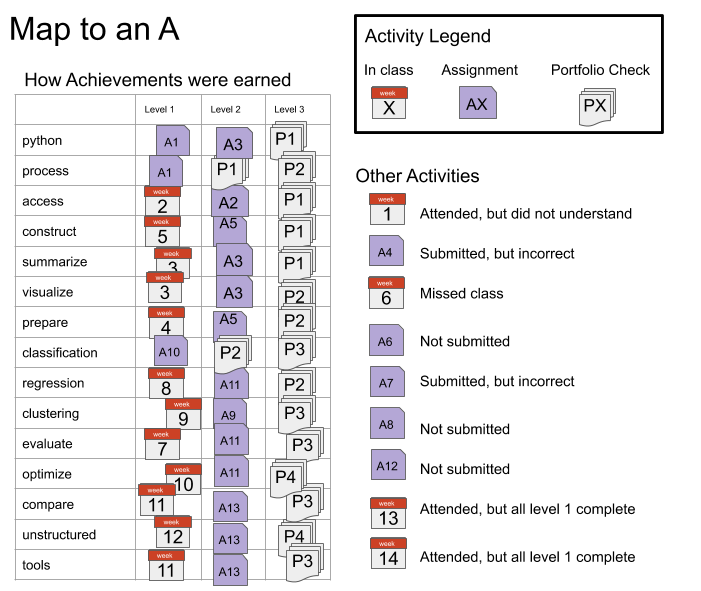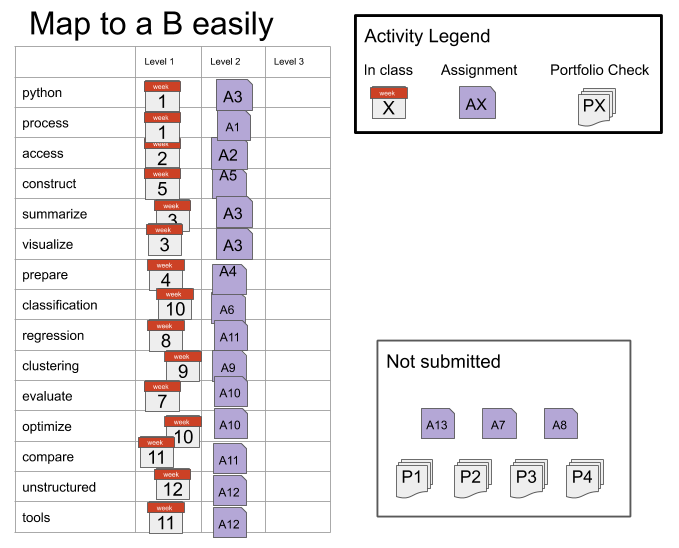Grading#
This section of the syllabus describes the principles and mechanics of the grading for the course. This course will be graded on a basis of a set of skills (described in detail the next section of the syllabus). This is in contrast to more common grading on a basis of points earned through assignments.
Principles of Grading#
Learning happens through practice and feedback. My goal as a teacher is for you to learn. The grading in this course is based on your learning of the material, rather than your completion of the activities that are assigned.
This course is designed to encourage you to work steadily at learning the material and demonstrating your new knowledge. There are no single points of failure, where you lose points that cannot be recovered. Also, you cannot cram anything one time and then forget it. The material will build and you have to demonstrate that you retained things.
Earning a C in this class means you have a general understanding of Data Science and could participate in a basic conversation about all of the topics we cover. I expect everyone to reach this level.
Earning a B means that you could solve simple data science problems on your own and complete parts of more complex problems as instructed by, for example, a supervisor in an internship or entry level job. This is a very accessible goal, it does not require you to get anything on the first try or to explore topics on your own. I expect most students to reach this level.
Earning an A means that you could solve moderately complex problems independently and discus the quality of others’ data science solutions. This class will be challenging, it requires you to explore topics a little deeper than we cover them in class, but unlike typical grading it does not require all of your assignments to be near perfect.
Grading this way also is more amenable to the fact that there are correct and incorrect ways to do things, but there is not always a single correct answer to a realistic data science problem. Your work will be assessed on whether or not it demonstrates your learning of the targeted skills. You will also receive feedback on how to improve.
How it works#
Warning
This is going to change; you will get a notificaiton when it is final
There are 15 skills that you will be graded on in this course. While learning these skills, you will work through a progression of learning, first getting the basic idea, then applying it, then exploring advanced usage. You will have to demonstrate each skill area on 3 separate occasions to get level 3 credit for it. Your grade will be based on earning 45 achievements that are organized into 15 skill groups with 3 levels for each.
These map onto letter grades roughly as follows:
If you achieve level 1 in all of the skills, you will earn at least a C in the course.
To earn a B, you must earn all of the level 1 and level 2 achievements.
To earn an A, you must earn all of the level 1 and level 2 achievements and at least 10 level 3 or other demonstrations of independent extensions beyond what was covered in class time.
You will have at least three opportunities to earn every level 2 achievement. You will have at least two opportunities to earn every level 3 achievement.
Each level of achievement corresponds to a phase in your learning of the skill:
To earn level 1 achievements, you will need to demonstrate basic awareness of the required concepts and know approximately what to do, but you may need specific instructions of which things to do or to look up examples to modify every step of the way. You can learn level 1 in any assignment (even without completing it completely correct) or in office hours.
To earn level 2 achievements you will need to demonstrate understanding of the concepts and the ability to apply them with instruction after earning the level 1 achievement for that skill. Weekly assignments will guide you to level 2, if you complete it well.
To earn level 3 achievements you will be required to consistently execute each skill and demonstrate deep understanding of the course material, after achieving level 2 in that skill. This will happen mostly extending previous assignments in your portfolio.
For each skill these are defined in the Achievement Definition Table
Participation#
While attending synchronous class sessions, there will be understanding checks and in class exercises. Completing in class exercises and correctly answering questions in class is approximately the level of understanding required for level 1.
We will not directly add these to your grade, but you can always visit office hours to earn level 1, so that your assignment can go straight to 2 in most skills.
Assignments#
For your learning to progress and earn level 2 achievements, you must practice with the skills outside of class time. You wil submit all of your assignments in your portfolio repository. Sometimes you will need to sync your repo to get templates for the assignment and some will be open. All will be posted on this site.
Assignments will each evaluate certain skills. After your assignment is reviewed, you will get qualitative feedback on your work, and an assessment of your demonstration of the targeted skills. Your feedback will recap all of your earned achievements to that point, not only what was earned in that assignment.
You can revise assignments if you do not earn achievements by also adding reflections to them while you edit, but since each skill is available in multiple assignments you do not have to.
You can revise what you submitted and resubmit it, with reflections and explanation of what you were confused about, what you tried initially, how you eventually figured it out, and explains the correct answer.
Extensions#
Warning
the logistics of this are changing, but tbd, will update soon
To earn level 3 achievements, you will extend your prior work. Starting with assignment 2, there will be extension ideas in the assignment.
TLDR#
You could earn a C through oral exams in office hours alone. To earn a B, you must complete assignments. To earn an A you must complete assignments and add extensions that demonstrate deeper understanding (tips will be provided).
Detailed mechanics#
The table below shows the minimum number of skills at each level to earn each letter grade.
| Level 3 | Level 2 | Level 1 | |
|---|---|---|---|
| letter grade | |||
| A | 15 | 15 | 15 |
| A- | 10 | 15 | 15 |
| B+ | 5 | 15 | 15 |
| B | 0 | 15 | 15 |
| B- | 0 | 10 | 15 |
| C+ | 0 | 5 | 15 |
| C | 0 | 0 | 15 |
| C- | 0 | 0 | 10 |
| D+ | 0 | 0 | 5 |
| D | 0 | 0 | 3 |
For example, if you achieve level 2 on all of the skills and level 3 on 7 skills, that will be a B+.
If you achieve level 3 on 14 of the skills, but only level 1 on one of the skills, that will be a B-, because the minimum number of level 2 achievements for a B is 15. In this scenario the total number of achievements is 14 at level 3, 14 at level 2 and 15 at level 3, because you have to earn achievements within a skill in sequence.
The letter grade can be computed as follows
Important
this will be revealed after assignment 1
Grading Examples#
Getting an A Without Perfection#
Warning
acheivements are no longer awarded in class in fall 24; images to be updated and porfolio is rolling instead of discrete check points.

In this example the student made several mistakes, but still earned an A. This is the advantage to this grading scheme.
For the python, process, and classification skills, the level 1 achievements were earned on assignments, not in class.
For the process and classification skills, the level 2 achievements were not earned on assignments, only on portfolio checks, but they were earned on the first portfolio of those skills, so the level 3 achievements were earned on the second portfolio check for that skill.
This student’s fourth portfolio only demonstrated two skills: optimize and unstructured. It included only 1 analysis, a text analysis with optimizing the parameters of the model.
Assignments 4 and 7 were both submitted, but didn’t earn any achievements, the student got feedback though, that they were able to apply in later assignments to earn the achievements.
The student missed class week 6 and chose to not submit assignment 6 and use week 7 to catch up.
The student had too much work in another class and chose to skip assignment 8.
The student tried assignment 12, but didn’t finish it on time, so it was not graded, but the student visited office hours to understand and be sure to earn the level 2 unstructured achievement on assignment 13.
Getting a B with minimal work#

In this example, the student earned all level 1 achievements in class and all level 2 on assignments. This student was content with getting a B and chose to not submit a portfolio.
Getting a B while having trouble#

In this example, the student struggled to understand in class and on assignments. Assignments were submitted that showed some understanding, but all had some serious mistakes, so only level 1 achievements were earned from assignments. The student wanted to get a B and worked hard to get the level 2 achievements on the portfolio checks.
